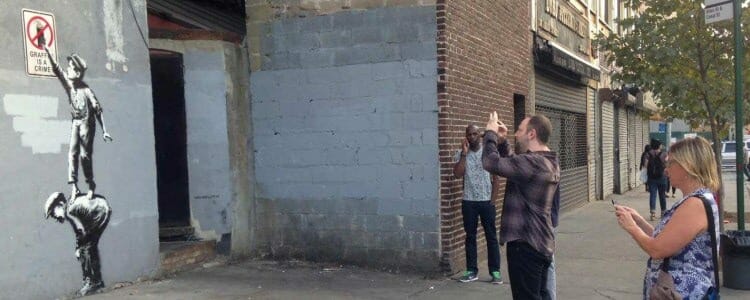Banksy, the London-based graffiti-artist who is currently one of the most famous living artists has been sharing a new piece of art every day on the streets of New York City. The growing popularity has been fueled by Mayor Bloomberg’s calls to arrest him. The artist who does not appear publicly but instead shares an image of each new piece of art every morning on the website, http://www.banksyny.com/ and for several hours last week hired a man to sell Banksy originals, which can go for 6 to 7 figures on the street for $60.
 As financial marketers, we often think we have nothing to learn from non-traditional marketing strategies and certainly Banksy is among the least traditional. But what could we learn from Banksy? (And with a name like “BANKsy, we need to talk about it.)
As financial marketers, we often think we have nothing to learn from non-traditional marketing strategies and certainly Banksy is among the least traditional. But what could we learn from Banksy? (And with a name like “BANKsy, we need to talk about it.)
It’s not about a gallery (branch). Traditional artists think that the nicer the gallery, the more art they will sell at a higher price. Banksy shows that people want something of value and they will work to find it. In fact by becoming more undercover Banksy has shown that people will share information without a location. Banksy has found a way to exploit digital channels. Twitter has embraced the #banksyNY tag and people who would not typically share art are doing so. This is what disrupters do.
Create mystery, not just marketing. Banksy has fans trekking through Manhattan to find random art pieces. Allowing prospective customers or members to wonder about the potential is a good thing. Most financial marketers find creative ways to display information, not creative ways to develop intrigue. Create a narrative.
The Death of the Branch: Consumer Behavior is the Killer App http://t.co/N2p7ey5ebG @brettking on @CookeonCUs
— Bradley Leimer (@leimer) May 6, 2013
Repeat the Experience. If Banksy only made one piece of art, regardless of quality, it would not be newsworthy. But making a new piece of art daily for a month is called a “campaign”. It also produces a sense of engagement with a following. Defining a contest or campaign gives your following an understanding of what is to come. We just have to be better at helping prospects know what is to come. Engagement isn’t just having them be your customer and check account balances as Ron Shevlin would suggest. Engagement needs to also mean sharing with others your experience.
Dear Bankers: Checking an account balance 15 times/week on a mobile device does NOT make a customer "engaged." http://t.co/5IvUKtJ18w
— Ron Shevlin (@rshevlin) May 3, 2013
Don’t measure engagement by people who walk through the door. My wife and I enjoy viewing art galleries when we travel to other major cities, and nearly every one counts the traffic through the door. Many banks think that this same metric is the goal for potential. Rather, consider how you might track engaged customers/members. How many are willing to share a positive experience about their financial institution?
It is a challenge to maintain disruption; however, what if better relationships were disruptive? What if our customers believed we were creating something artful and had a bigger purpose?


